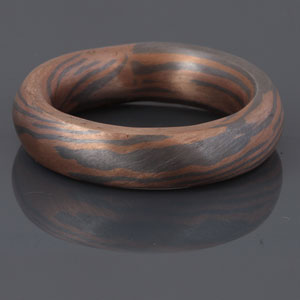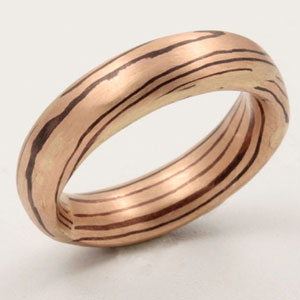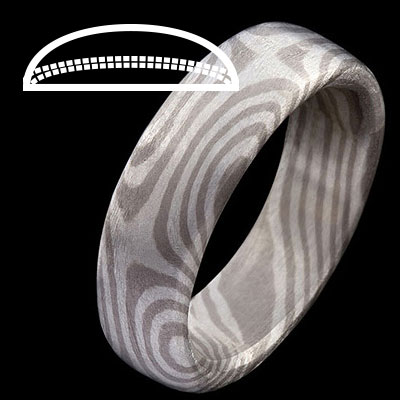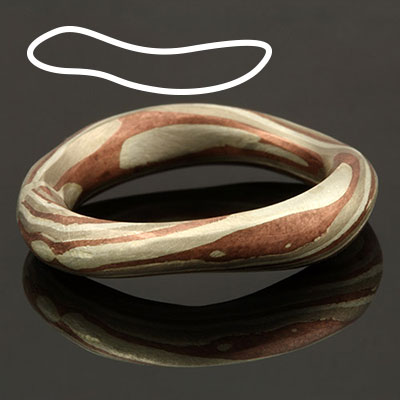THE UNIQUE CELEBRATION OF COLOUR IN MOKUME GANE DESIGNS
Mokume Gane jewellery suits both men and women.The rings make unusual, earthlike looking bands which can easily be worn as wedding bands by both men and women.
The uniqueness of these is in the fact that each ring is made separately, individually, thus a one-off creation is made, without an identical copy.
It is possible though, to create two rings from the same billet, using the same patterning techniques and thus create a pair of rings which will be close in their look and feel – but still not identical. And this is really the beauty of Mokume Gane. Each piece stands on its own, and is unique as each person’s fingerprint.
Again, Mokume Gane is all about a celebration of colours and shapes, as is the majority of our designs. This is the reason we leave the fusion unpolished, or matt- finished, so the various colours of the different metals will stand out and the patterns will become more dominant.
COLOUR OPTIONS IN OUR MOKUME GANE RINGS
There are many different options of colour combinations in the Mokume Gane. When ordering your special Mokume Gane piece from us – you are welcome to choose any colours that your heart desires:
- Grey is created from 18 karat white gold and palladium
- White is created from sterling silver
- Yellow is created from 18 karat yellow gold - or for more intense yellow colour, from 22 karat yellow gold
- Red is created from 18 karat rose gold (which has copper in it )
- Brown-black is created from Shakudo, which is a combination of 4% pure gold (24 karat) and 96% copper, which gives it its characteristic dark colour. The Shakudo creates a strong contrast in colour with any of the other metals mentioned.
MOKUME GANE RING PROFILES
Mokume gane rings may be made in a variety of profiles according to your taste.
TWO TYPES OF MOKUME GANE JEWELLERY
SOLID FUSION OR SLEEVE FUSION?
In solid fusion the patterns in the metal go right through and can be seen on the inside of the ring.
The second type is the sleeve fusion where the Mokume Gane patterns are only a thin layer of the piece and can be seen just on the surface of it rather than right through.The inside of the piece will consist of an additional piece of metal of one type, such as yellow gold, white gold or rose gold.
Of course the real value is in the solid Mokume Gane. The difference between solid Mokume Gane and the sleeve Mokume Gane is like the difference between a solid Opal (where the whole stone is a natural piece of Opal) and a triplet Opal (where a thin layer of the Opal is glued onto a plastic backing to support it).
The solid fusion pieces are significantly harder to make because the billet itself is much thicker – and therefore harder to manipulate – in order to make the actual piece. Moreover, if the fusion of the layers in the billet is not absolutely perfect, and there are some weak points in the joining areas of the layers, those will definitely open up and dismantle the billet while the piece is being made.
The thicker and wider the solid Mokume Gane billet is, the harder it is to bend and work the metal in order to make the piece. That is why rings like those displayed here of 10 mm width x 2 mm thickness are very rare, and only a handful of jewellers worldwide make them.
Another significant advantage that the solid fusion has over the sleeve fusion, is the fact that its durability is much higher. This means that when it gets scratched or worn, you do not have to worry about damaging the patterns of the jewellery piece (if you decide to remove the scratches) since they go right through, so under each layer there are many more. This is definitely not the case with the sleeve fusion, where cleaning means there is a great chance that the patterns, which are only a very thin layer in the piece, will be damaged. The thickness of the layers in a sleeve fusion piece is usually between 0.75 to 1 mm (and therefore not recommended.)
In a solid fusion the thickness of the layers in the piece is 2mm – 3mm, which is significantly thicker. This means that there is a much higher gold content in the solid fusion pieces than in the sleeve fusion pieces and therefore a price difference too. One solid fusion piece can make three to four sleeve fusion pieces!
Eytan obviously recommends the solid fusion, which he uses in most of his Mokume Gane pieces, but will also make the sleeve fusion if the customer so wishes.
Eytan's Commentary
I honestly believe that the beauty of solid fusion jewellery is in its organic and simple look, and I try to leave them as natural, woodlike, flowing, silky and simple as I possibly can.


.JPG)
.JPG)

.JPG)










